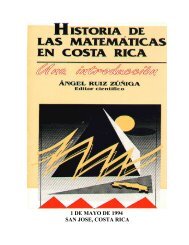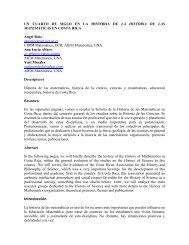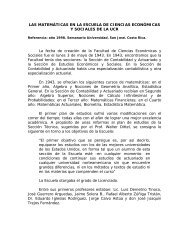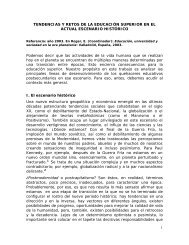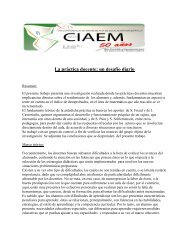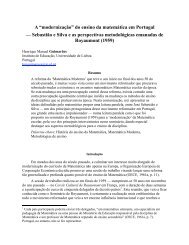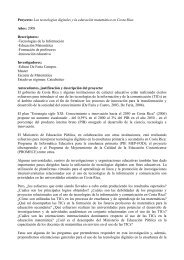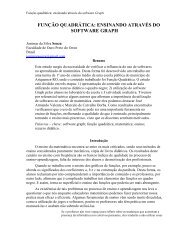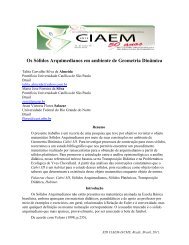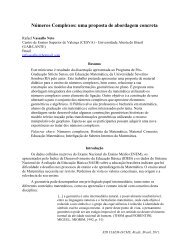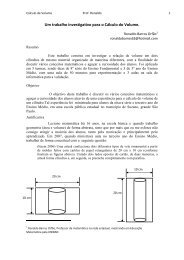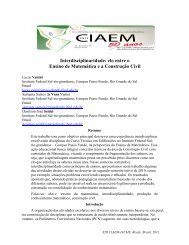Didactics of mathematics: more than mathematics and school! - CIMM
Didactics of mathematics: more than mathematics and school! - CIMM
Didactics of mathematics: more than mathematics and school! - CIMM
Create successful ePaper yourself
Turn your PDF publications into a flip-book with our unique Google optimized e-Paper software.
168 R. Straesser<br />
developmental project piloted by Steiner <strong>and</strong> Straesser)<br />
stressed the importance <strong>of</strong> <strong>mathematics</strong> for this<br />
vocational area, but also pointed to the fact that<br />
<strong>mathematics</strong> is used as a ‘strategic’ tool to model the<br />
workplace situation, to fulfil the quantification needs <strong>of</strong><br />
the vocational situation in order to have easy predictions<br />
<strong>of</strong> the application <strong>of</strong> machines <strong>and</strong> procedures.<br />
Mathematics is not needed as such, it <strong>of</strong>fers a (very<br />
versatile) tool to model the workplace situation. Consequently,<br />
the vocational theory is not interested in a<br />
deep underst<strong>and</strong>ing <strong>of</strong> mathematical concepts or procedures,<br />
but in an effective <strong>and</strong> fast prediction <strong>of</strong> the<br />
vocational situation (loc. cit., p. 118).<br />
A comparable description can be found for the<br />
workplaces related to (traditional, not computer related)<br />
electricity: Rauner (1984, p. 151) denies <strong>mathematics</strong><br />
an independent role in the training <strong>of</strong> future<br />
qualified worker in electricity surroundings, but mentions<br />
the role <strong>of</strong> <strong>mathematics</strong> as a help to underst<strong>and</strong><br />
vocational situations—with trigonometric functions as<br />
the prototypic example helping to underst<strong>and</strong> alternating<br />
current. He even goes as far as saying that<br />
underst<strong>and</strong>ing electro technical devices is simply<br />
impossible without <strong>mathematics</strong>—but wants these<br />
mathematical models preferably presented in diagrams<br />
<strong>and</strong> graphs, not in numbers or equations (loc. cit., p.<br />
152f; for examples see the end <strong>of</strong> his paper).<br />
2.3 The utilitarian reduction<br />
Looking into <strong>mathematics</strong> in vocational training <strong>and</strong><br />
education is one efficient way to walk out <strong>of</strong> the<br />
classroom to study <strong>mathematics</strong> <strong>and</strong> its use out <strong>of</strong><br />
<strong>school</strong>. This nevertheless implies a temptation, which<br />
Hans-Georg Steiner always resisted, but should nevertheless<br />
be mentioned: Studying workplace use <strong>of</strong><br />
<strong>mathematics</strong> <strong>of</strong>ten tends to reduce the purpose <strong>of</strong><br />
<strong>mathematics</strong> to its importance for aims outside <strong>mathematics</strong>.<br />
Falling into this trap implies the idea, that<br />
teaching <strong>and</strong> learning <strong>of</strong> <strong>mathematics</strong> is (mainly, if not<br />
only) done for utilitarian reasons, for the sake <strong>of</strong> the<br />
role <strong>of</strong> <strong>mathematics</strong>’ in its applications. From the<br />
description <strong>of</strong> the developmental project mentioned<br />
above, one can see that Steiner (<strong>and</strong> his team) did not<br />
reduce vocational training to utilitarian purposes.<br />
Apart from three other problems <strong>of</strong> teaching <strong>mathematics</strong><br />
in this type <strong>of</strong> vocational training, the project<br />
wanted to take into account the tension between<br />
vocational <strong>and</strong> general education (in German: ‘‘beruflicher<br />
und allgemeiner Bildung’’, see Steiner <strong>and</strong><br />
Straesser 1982, p.16).<br />
The modelling approach <strong>of</strong> Sect. 2.2, especially the<br />
comments from the metalwork <strong>and</strong> electricity area,<br />
already show that a simplistic utilitarian approach to<br />
<strong>mathematics</strong> is inappropriate for vocational training—last<br />
not least because the sheer practice <strong>of</strong> the<br />
workplace is not interested in the workers underst<strong>and</strong>ing<br />
the processes <strong>of</strong> production <strong>and</strong> distribution,<br />
but will only look into a continuous functioning <strong>of</strong><br />
machines <strong>and</strong> the labour force. Research into <strong>mathematics</strong><br />
at the workplace has shown the limitations <strong>of</strong><br />
such an approach in <strong>more</strong> detail: as long as the production/distribution<br />
process goes uninterrupted by<br />
unexpected events, goes without (unforeseen) problems,<br />
underst<strong>and</strong>ing the process (maybe with the help<br />
<strong>of</strong> <strong>mathematics</strong>) is not necessary, sometimes even disturbing.<br />
The worker may even override the information<br />
produced by a mathematical model.<br />
A nice confirmation <strong>of</strong> this statement from the<br />
banking sector may be the comment <strong>of</strong> a person ‘‘in<br />
charge <strong>of</strong> support <strong>and</strong> maintenance <strong>of</strong> computer<br />
equipment’’ in an investment bank (see Noss <strong>and</strong><br />
Hoyles 1996, p. 7f). He commented his evaluation <strong>of</strong> a<br />
piece <strong>of</strong> equipment by using a pre-programmed<br />
spreadsheet by ‘‘I press the button <strong>and</strong> see what it says.<br />
.... I look at the answer. If it seems to indicate what I<br />
think we should do, I use the number to justify my<br />
decision. If not, I ignore it, or put in figures which will<br />
support my hunch.’’ It its all too obvious that <strong>mathematics</strong><br />
cannot be used as an unquestioned, simple<br />
model <strong>of</strong> the vocational situation.<br />
A quote from an experienced teacher trainer in the<br />
metalworking area shows a different limitation <strong>of</strong> a too<br />
simplistic utilitarian reduction <strong>of</strong> the use <strong>of</strong> <strong>mathematics</strong><br />
in vocational situations: ‘‘Mathematics in<br />
vocational education is serving <strong>more</strong> as a background<br />
knowledge for explaining <strong>and</strong> avoiding mistakes, recognising<br />
safety risks, judicious measurement <strong>and</strong> various<br />
forms <strong>of</strong> estimation. ... Not practice at the<br />
workplace but deepening <strong>of</strong> the pr<strong>of</strong>essional knowledge,<br />
education to a responsible use <strong>of</strong> tools <strong>and</strong> machines<br />
<strong>and</strong> the underst<strong>and</strong>ing <strong>of</strong> <strong>and</strong> coping with<br />
everyday mathematical problems legitimise <strong>mathematics</strong><br />
in vocational education’’ (quoted from Appelrath<br />
1985, pp. 133–139; translation R.S.). In the<br />
statement from metalwork, <strong>mathematics</strong> takes a specific<br />
role to further an underst<strong>and</strong>ing <strong>of</strong> the workplace<br />
situation. It is not directly operative in the situation on<br />
the shop floor.<br />
2.4 Black boxes<br />
As a consequence, <strong>mathematics</strong> is far from obvious in<br />
vocational situations—somehow confirming the difficulties<br />
to identify vocational <strong>mathematics</strong> already<br />
mentioned in Sect. 2.1. Difficulties to find <strong>mathematics</strong><br />
123




